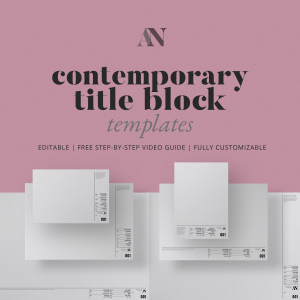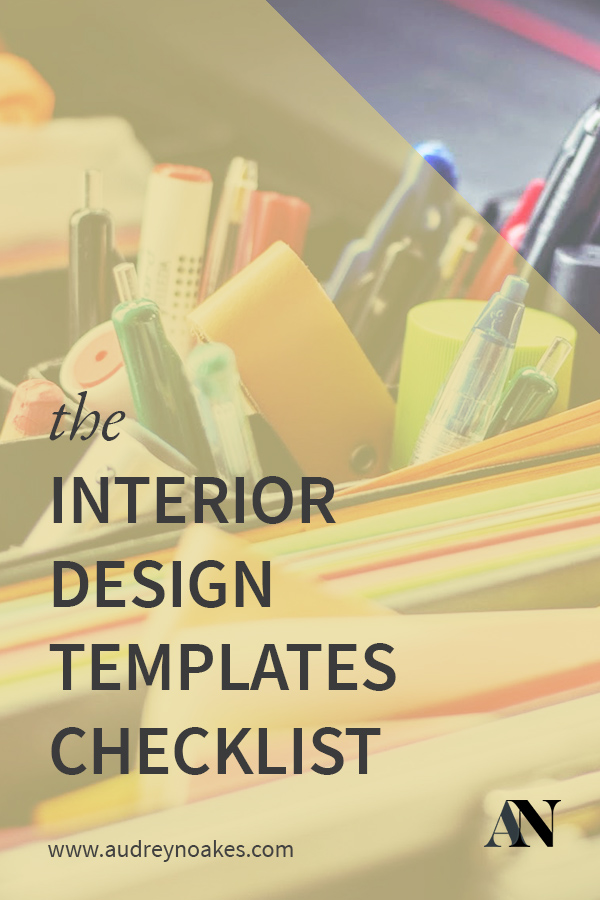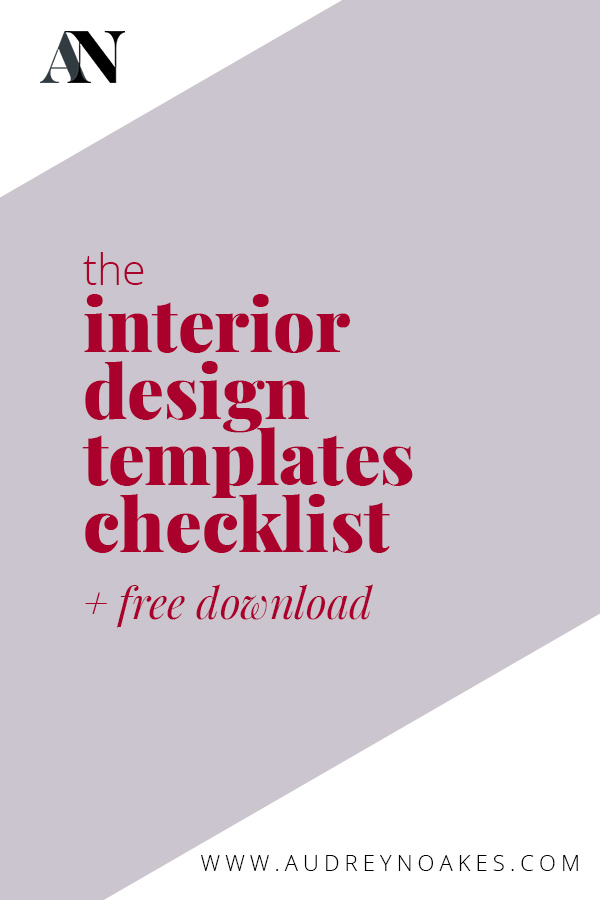
want your free templates checklist?
Making interior design templates is one of the best investments you can do to increase your efficiency. Having templates that are pre-made and pre-designed will let you get back to focusing on the design projects that you love. Here’s a good list to get you started on what templates you can make to make the running of your projects and practice easier.
Note: These project templates are organised in the general structure of the RIBA Plan of Work, often used in the UK.
Pre-project Templates
- Project Proposal template – Having an InDesign document ready to go with all the framework you need to assemble a winning proposal will save you time and keep your professional presentation consistent.
- Fee Proposal template – You may need a few fee proposal templates, to help accommodate various types of projects you work on. Consider a fee proposal that’s a straight design project, a fee proposal that’s design and FF&E purchasing, etc. Essentially, you’re giving yourself a form to fill in to help you assemble a thorough and accurate fee proposal. Don’t forget to show inclusions and exclusions as well to make sure the fee proposal is clear.
- Cover Letter template – This will obviously change from project to project but having a base letter to build upon will make it so much quicker and easier to write these letters (or emails) quickly.
- Project Scope of Works template – This will also likely change from project to project but having a very thorough ‘starter scope of works’ will give you something to edit to produce the correct one for the relevant project easily.
- Project Terms Template / Contracts / Letters of Agreement templates – Now any legal document like your terms, your contracts, and/or your letters of agreement should really be reviewed by a lawyer to ensure they’re fair to you and your clients. But once it has been reviewed, these should be come templates that can be customised with amendments as needed.
Project Templates
Brief
- Project Initial Brief Questionnaire template – Now this is likely more suitable for residential interior design clients, but already having a template in place to collect this crucial information from your clients will make your life easier.
- Project Brief template – No matter how you present to client the brief, having a template of that presentation will be helpful. It can be an InDesign document with clear sections outlining exactly what is involved in the project and what’s understood about the project at this stage.
- Project Scope of Works post-brief template – Equally, go ahead and have the Scope of Works templates ready. This way any changes post-brief can be edited and applied.
- Client Confirmation template – You know that letter of email that you write to your client getting them to confirm they’re happy to proceed to the next stage of the design process? That’s likely a really similar letter from client to client. Therefore, go ahead and make a template for it.

want some templates to work faster?
Concept
- Survey requests templates – Basically any kind of letter you send out regularly, should be made into a template. When you’re sending this via email, you can easily set up email templates or canned responses in your email provider. See this blog post on how you can make your email work more efficiently. Therefore, the letters/emails you send asking a surveyor for a quote or for appointment could be a template. That way you really only have to change the project information each time.
- Prospective consultants templates – I’m just repeating myself at this point, but have a template for the letters you send to various consultants enquiring about their availability.
- Consultant appointment templates – When you’ve picked those consultants, have a template ready to go to confirm their appointment. Might as well have a template confirming a consultant has not been selected, too.
- Project team template – When the project team is assembled, have a template ready to go to record each of their information. This information may be just for you to keep track for smaller projects, but for larger projects that require things like matrixes of responsibility, recording the project team in a way for easy distribution will be time-saving.
- Concept design package template – Go ahead and have a template ready to go in creating your concept design package. You can go ahead and decide what you need to include in typical concept design packages. Create this graphic framework now, where all you have to do is input the design and content specific to the project. This could potentially save you hours with each project.
- Concept board or mood board templates – Concept design packages likely will include things like concept boards and mood boards, so you should go ahead and have a template for these things. This can literally just be branded frames in which you’ll have to insert content. But having the template will shave time off the production of these documents. Check out this blog post for how to make mood board templates in InDesign.
- Concept drawing title block templates – One of the first templates anyone will need to create when they’re making drawings is the title block. You’ll likely need to consider different title blocks for different stages of the project. The concept design phase usually won’t require too detailed of a title block, as it’s not to the point of revisions and other complexities.
- Concept design schedules template – Things like doors, windows, FF&E, etc. will need schedules. Go ahead and have templates set up where you can produce professional, organised, and branded schedules quickly.
- Client Confirmation template – Just like with the Brief stage, you know that letter of email that you write to your client getting them to confirm they’re happy to proceed to the next stage of the design process? Go ahead and make a template for the Concept Design stage, too.
A lot of these templates can be created in my #1 favorite software program: InDesign.
need to get InDesign?
This is an affiliate link, meaning I earn an affiliate commission if you decide to subscribe. However, I recommend no matter what. 🙂
Design Development
- Letters to municipal authority and/or council templates – There will likely be some similarities in the letters you send to various municipalities regarding your project work, especially if you need permissions. Now, some jurisdictions will have requirements in how they are communicated with. If you’re consistently working in the same area, have templates ready to go to edit and format with each project.
- Design development package templates – Just like with your Concept Design Package, go ahead and have a template ready to go in creating your Design Development Package. Include all the typicals you need in your design development packages. Create the graphic framework again now, where all you have to do is input the design and content specific to the project. This could potentially save you hours with each project.
- Furniture board templates – Similar to mood boards, go ahead and set up some graphic framework in which you can input furniture and material images. Add your branding and keep it all consistent.
- Sample board templates – This can be easier said than done, depending on the samples. However, you could set up some basic compositions with branding for you to use as the base for when do need to create sample boards.
- Design development drawings title block templates – Design development drawings’ title blocks will need quite a bit more detail than your concept design drawings. Go ahead and set these up where all your drawings can be tidily presented.
- Outline specifications templates – Having not only a template for the formatting of your specifications, but also having the template information of some of your favorite materials, fixtures, and furnishings will make the assembly of your project specifications quick and easy.
- Client Confirmation template – You know the drill.

want some templates to work faster?
Technical Design
- Technical Design package templates – These packages will be more complex and more specific. Have a template. Make your life easily.
- Technical Design drawing title block templates – In many cases, your technical design drawings’ title block can really be the same as your design development title block. Just make sure you have all the technical notes required.
- Specifications templates – These specifications are also more complex and thorough. You can build these off of your Outline Specifications, but because they’re more thorough, give yourself a template to make the creation of these lengthy documents easy.
- Schedules templates (including FF&E) – Similar to your earlier schedules, have a template.
- Schedule of works templates – Similar to your earlier schedule of works, have a template.
- Client Confirmation template – Yep, another template.
Pre-Construction
- Letters to contractors templates – Go ahead and have a templates ready for those letters and emails your write to contractors enquiring about their availability and obtaining quotes.
- Contractor appointment templates – Have templates for your responses to these contractors ready to go.
- FF&E Purchase Order templates – If you’re doing any purchasing for your clients, have purchase order templates ready to go.
- FF&E Sales Order templates – If you’re doing any retail sales, go ahead and have sales order templates ready to go.
Construction
- Site visit report templates – It’s a good idea to have a template for your site visit reports. Have a template for your notes about different aspects of the project. Have a system in place on how you record your site photographs as well.
- Letter of completion templates – Having a template ready to go when the project has finally reached completion will make you even happier.
- Letter to photographers template – When you want to have a project photographed, it will be quick and easy to go ahead and have an enquiry letter/email ready to send to your prospective photographers.
- Photographer appointment templates – Have a template for your responses, too.
Practice Templates
- Letterhead templates – Good ol’ reliable letterhead.
- Email signature templates – The 21st century’s version of letterhead. Have a complete and branded email signature.
- New Enquiry templates – Have templates ready to go to answer any potential new clients.
- Meeting Minutes templates – Have a template ready to help you format and organise your meeting minutes. Have the template ready for you and the necessary parties’ signing off, too.
- Project Invoice templates – This is probably the most important template you can make because it’s the template that ensures you get paid. Now likely you’ll need to have a system in place for sending invoices and handling payments. Within that system, you should be able to set up a branded and professional template.
- Thank you for your payment template – It’s a good idea to thank your clients for their payment, especially your residential clients. Have the template ready to go.
- Project time sheets template – Keeping time sheets for your projects will ensure you keep profitable in how you’re working. Having some sort of template ready to help you record your hours easily.
- Practice planning templates – When you’re juggling more than one project, it’s good to have some system in place to help you plan out your work. For example, is it a template for a yearly calendar to help you schedule out each project. Do you have a quarterly GANTT chart to help you map out your time over 3 months? Have a template in place to help ensure your planning is consistent and effective.
- Practice Brochure templates – Have a couple of brochures ready when you need to promote your practice. Consider having a 1-page brochure and perhaps a small half-page size brochure. Give yourself options in how you promote yourself.
- Practice Business cards – Of course, you’ll still need business cards.
- Practice/Designer Biography templates – in preparation of any publicity or press you receive, you should go ahead and write your bios when inevitable a writer or publisher asks for one. Cristina Katz has a helpful post on Jane Friedman’s website about the 3 types of bios you should write for yourself. While she’s focused on writers, the same principles can apply to designers too.

want some templates to work faster?
This is an incomplete list, but it should definitely give you a good idea of where you can get started when it comes to templates. To help distill this post into a more usable checklist, I’ve made a free PDF download.

want your free templates checklist?
What other templates can you think of to help you be more productive?
Until next time,
Audrey












